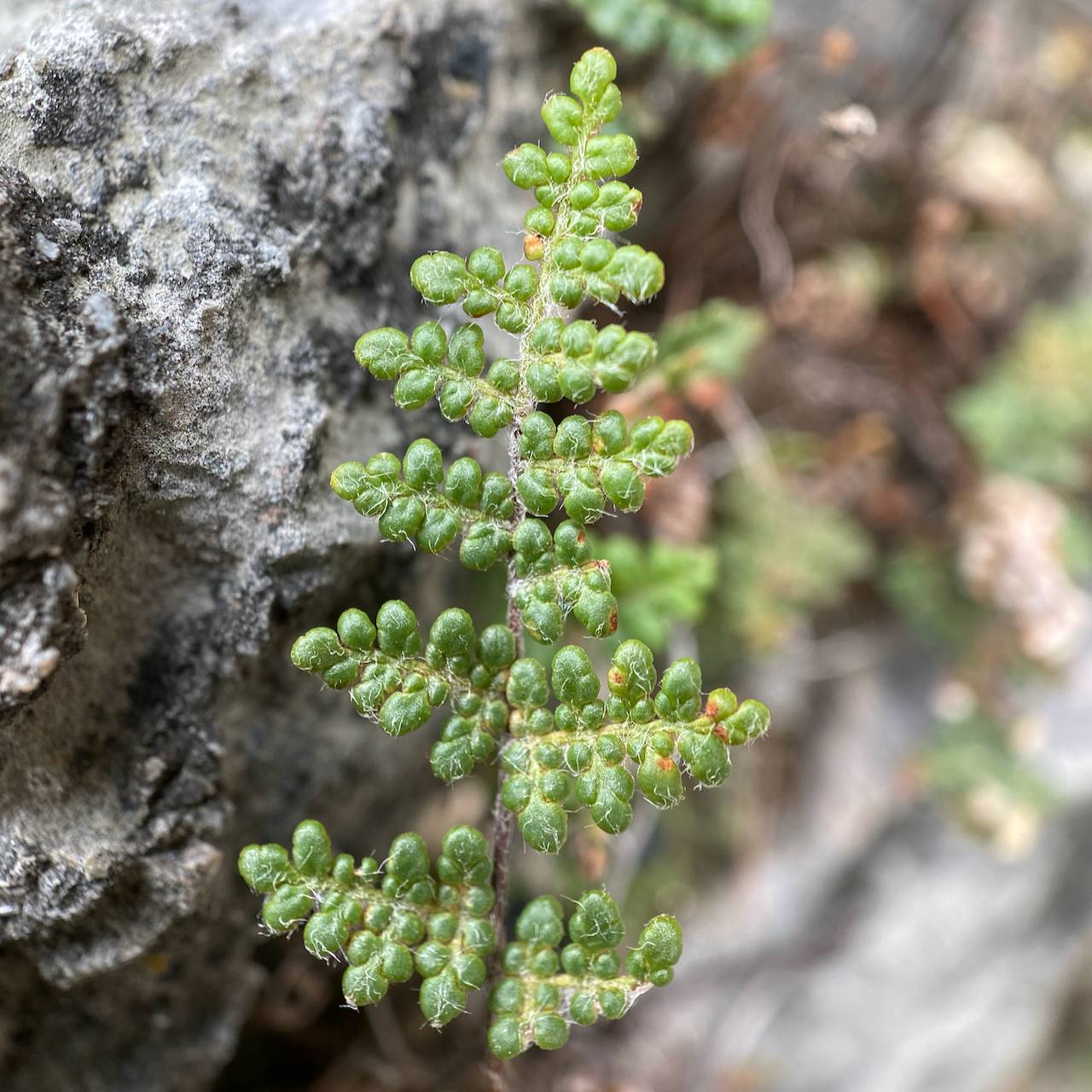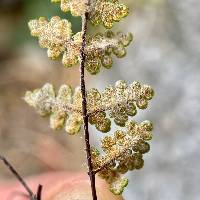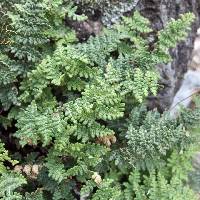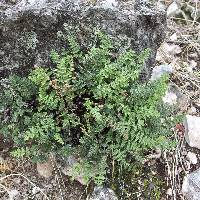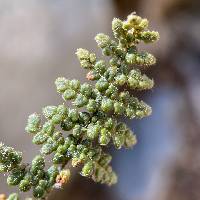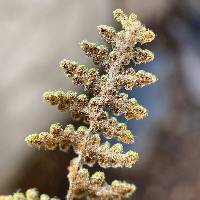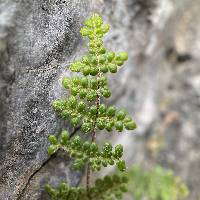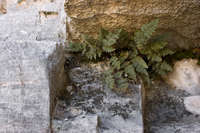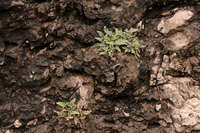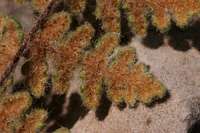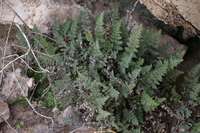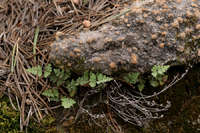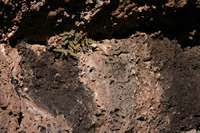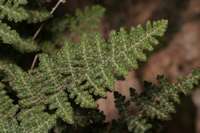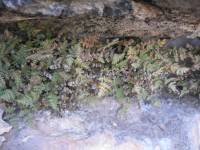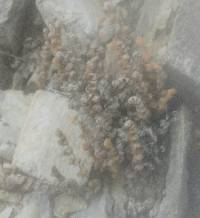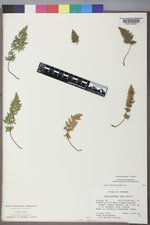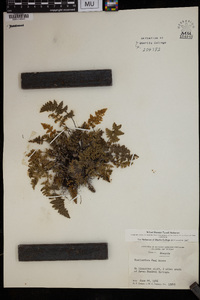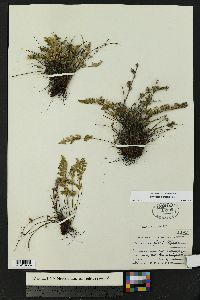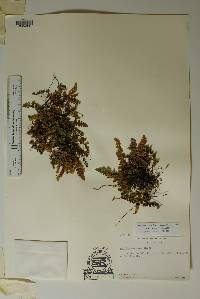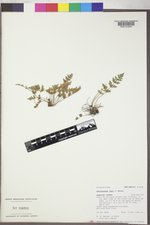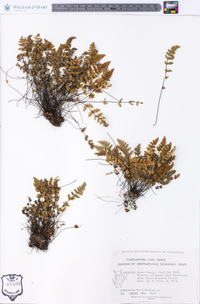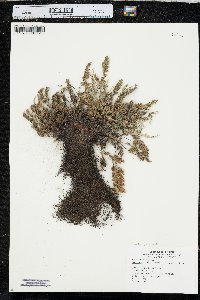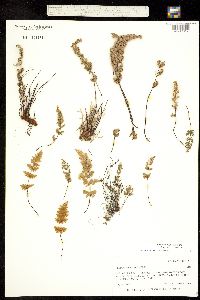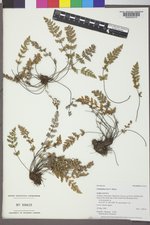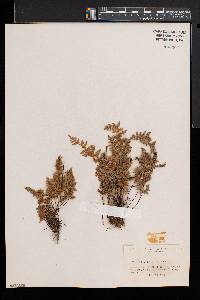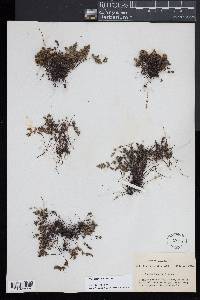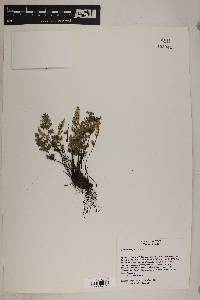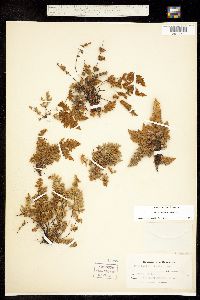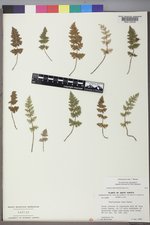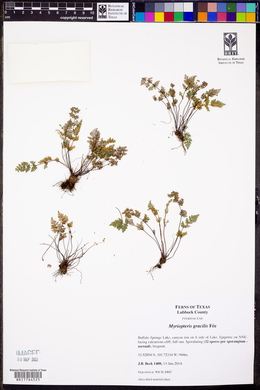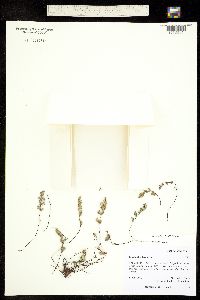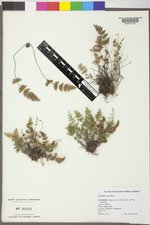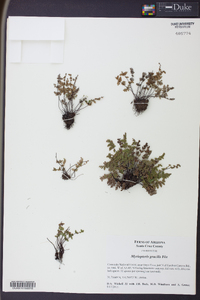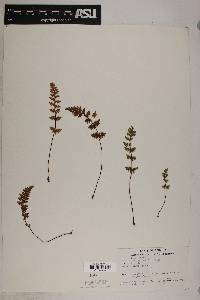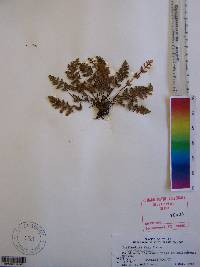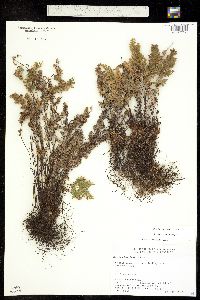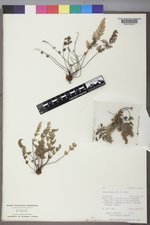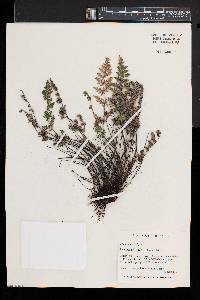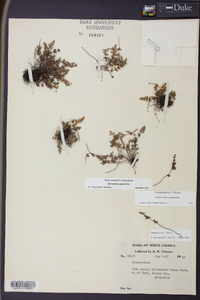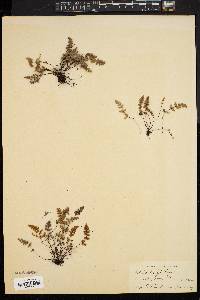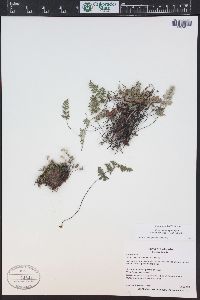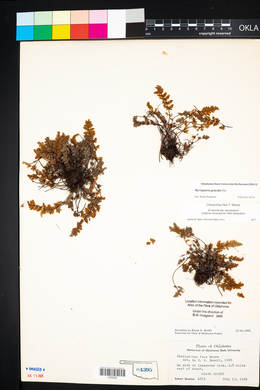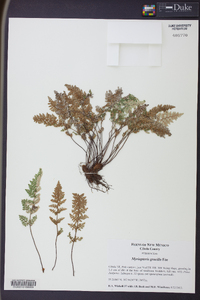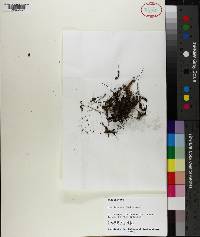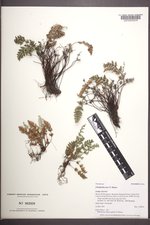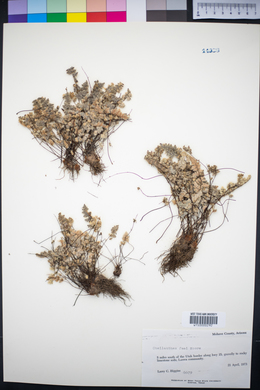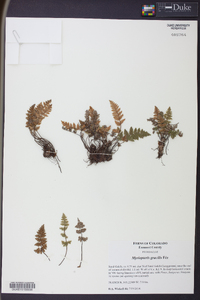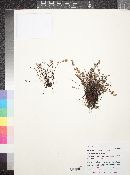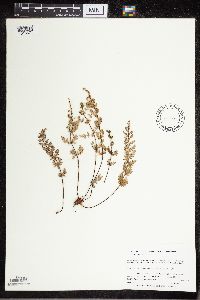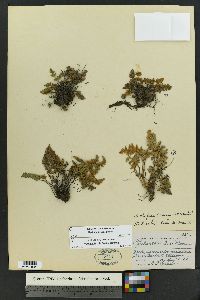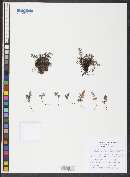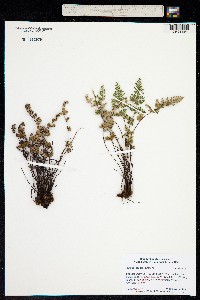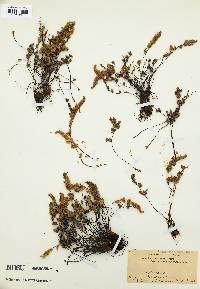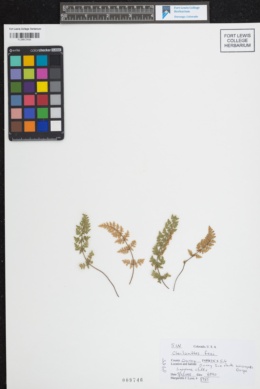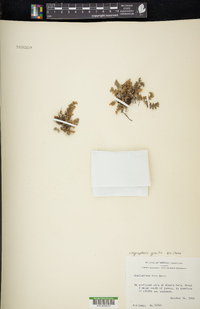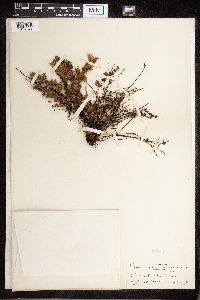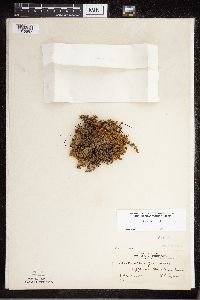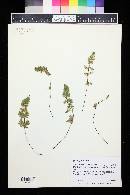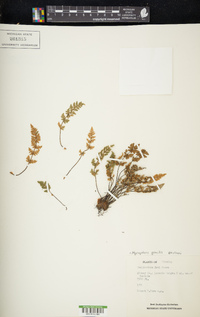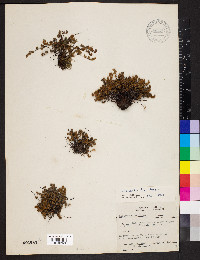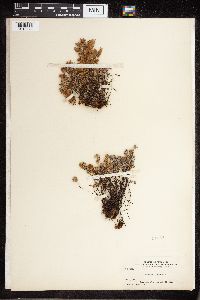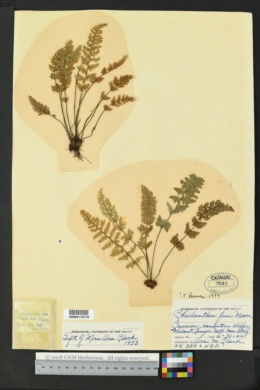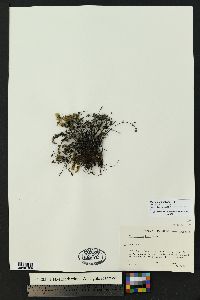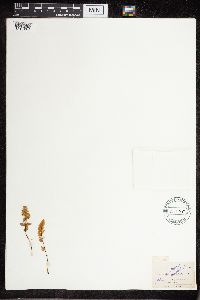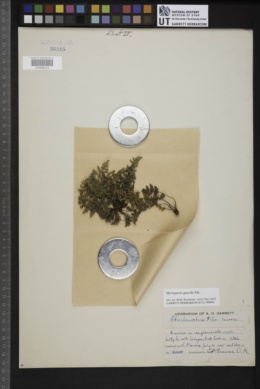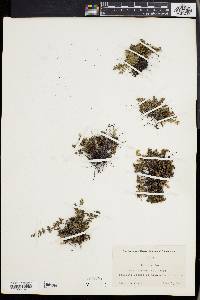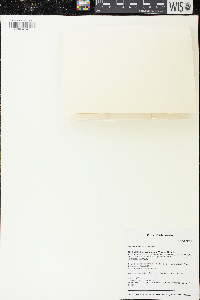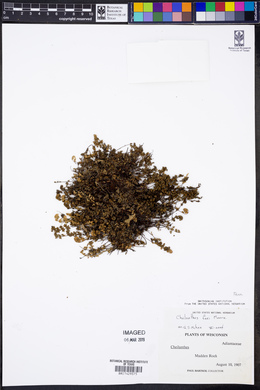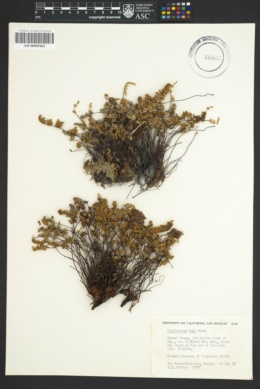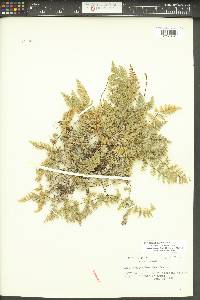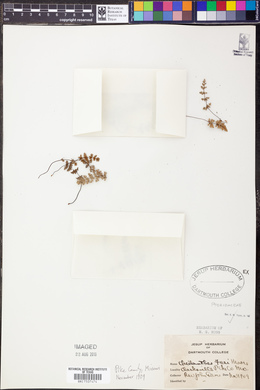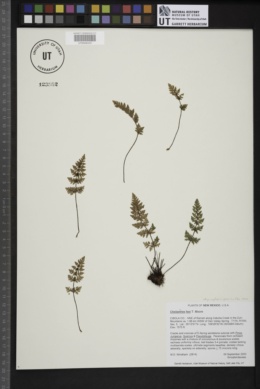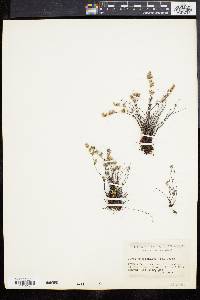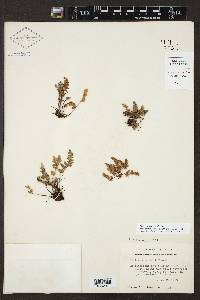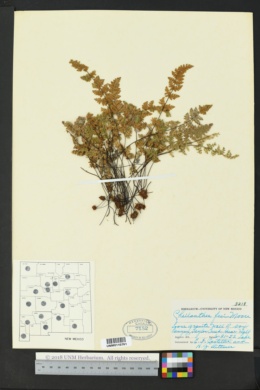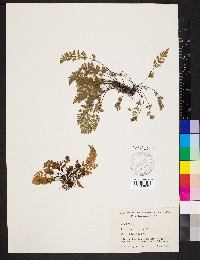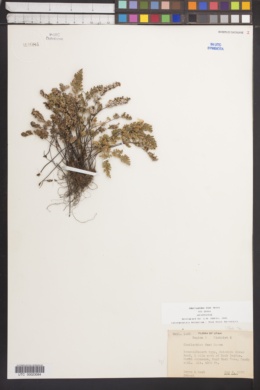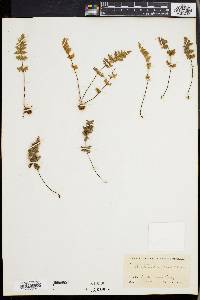Myriopteris gracilis
|
|
|
|
Family: Pteridaceae
Slender Lip Fern, more...slender lipfern, fee lipfern, Fee's lipfern, slender lipfern
[Cheilanthes feei T. Moore] |
Stems compact to short-creeping, usually 4--8 mm diam.; scales often uniformly brown but at least some on each plant with well-defined, dark, central stripe, linear-lanceolate, slightly contorted, loosely appressed, persistent. Leaves clustered, 4--20 cm; vernation circinate. Petiole dark brown to black, rounded adaxially. Blade linear-oblong to lanceolate, 3-pinnate at base, 1--3 cm wide; rachis rounded adaxially, lacking scales, with dense monomorphic pubescence. Pinnae not articulate, dark color of stalk continuing into pinna base, basal pair usually smaller than adjacent pair, ± equilateral, appearing sparsely pubescent to glabrescent adaxially. Costae brown adaxially for most of length; abaxial scales absent. Ultimate segments round to slightly oblong, beadlike, the largest 1--3 mm, abaxially densely villous with long, segmented hairs, adaxially sparsely hirsute to glabrescent. False indusia marginal, weakly differentiated, 0.05--0.20 mm wide. Sori ± continuous around segment margins. Sporangia containing 32 spores. n = 2 n = 90, apogamous. Sporulating late spring--fall. Calcareous cliffs and ledges, usually on limestone or sandstone; 100--3800 m; Alta., B.C.; Ariz., Ark., Calif., Colo., Idaho, Ill., Iowa, Kans., Ky., Minn., Mo., Mont., Nebr., Nev., N.Mex., Okla., Oreg., S.Dak., Tex., Utah, Va., Wash., Wis., Wyo.; n Mexico. Cheilanthes feei is an apogamous triploid of unknown parentage. It has small, beadlike blade segments similar to those of subg. Physapteris , but most morphological characteristics suggest a clear relationship to members of subg. Cheilanthes (T. Reeves 1979). The species is most often confused with C . parryi , from which it can be distinguished by its thinner, sparser pubescence and smaller ultimate segments.
FNA 1993, Dittmer 1954, Kearney and Peebles 1969, Grusz and Windham 2013, Martin and Hutchins 1980 Common Name: slender lipfern General: Small fern, to about 20 cm tall, from compact to short-creeping rhizomes, these 4-8 mm diameter; rhizome covered with brown scales, some of which have a darker central stripe. Leaves: A dense cluster of fronds emerges directly from the rhizome; petioles are dark brown to black, tomentose when young and becoming glabrous and shiny with age; blade 4-20 cm long and 1-3 cm wide, linear-oblong in outline, and 3-times pinnate; ultimate leaflets are round, 1-3 mm long or even smaller and bead-like, with the upper surfaces sparsely hairy and the lower surfaces densely covered with long hairs. Sporangia: Sporangia (spore-cases) are located on the leaflet undersides, densely lining the outer edges of the leaflets; the leaflet margin curls under to partly cover the sporangia, forming a false indusium. Ecology: Found on calcareous cliffs and ledges, usually on limestone or sandstone, from 2,000-7,000 ft (610-2134 m); sporulates late spring-fall. Distribution: w and c N. Amer., from B.C., CAN, south to CA; east to WI, IL, AR, and TX; south to MEX. Notes: Look for this plant under the name Cheilanthes feei, in texts and in the herbarium. Molecular evidence shows that species traditionally placed in the genus Cheilanthes are not all from a single evolutionary lineage, so botanists are in the process of splitting up the genus. The result is that most North American Cheilanthes are very recently placed in the genus Myriopteris. This species is fairly common and widespread, distinguished by the 2-3 times pinnate fronds with tiny round bead-like leaflets that have long straggly hairs in the undersides. The spores sometimes appear to cover the entire underside of the leaflets, and other times appear to only line the edge, surrounding a dense tuft of long tangled hairs. Ethnobotany: Unknown, but other species in the genus have uses. Etymology: Myriopteris is from the Greek words myrios, or myriad, and pteris, fern, because the frond is divided into so many leaflets; gracilis means slender. Synonyms: Cheilanthes feei Editor: SBuckley 2010, FSCoburn 2015, AHazelton 2017 Rhizome short, multicipital, its scales linear-subulate, 3-6 נ0.5 mm, orange-brown with black midstripe; lvs tufted, 5-20 cm, the petiole to 10 cm, equaling or shorter than the blade, dark purplish brown, long-hairy, not scaly; blade linear-oblong, 3-13 נ1.5-4 cm, 3-4 times pinnate, loosely and copiously villous-tomentose (usually tawny or rusty) beneath; pinnae 6-12 pairs, spaced out below, petiolulate, ovate to ovate-oblong; pinnules 3-6 pairs, their ultimate segments 2-3 pairs, commonly only 1-1.5 mm, the margins loosely inrolled but unmodified and not covering the mature sporangia, which often spread out over the lower surface; 2n=87 (triploid). Calcareous bluffs and rocks; Wis. and Ill. to Alta. and B.C., s. to Ark., Tex., and Ariz.; disjunct in Va. Gleason, Henry A. & Cronquist, Arthur J. 1991. Manual of vascular plants of northeastern United States and adjacent Canada. lxxv + 910 pp. ©The New York Botanical Garden. All rights reserved. Used by permission. |
|
|
|

